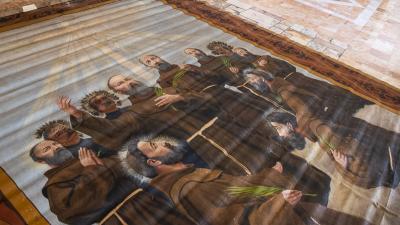
A magnifying glass, an ancient chalice, a book on stamps and an expert in sacred goldsmithery. This is what one can find at Saint Savior’s in April 2016. Giovanni Boraccesi is the expert in religious goldsmithery who spent ten days analyzing the Custody’s liturgical objects. “They have mostly never been studied, so I add to information that we obtain about them, but it would take a lifetime to study everything!” He says. “The stamps allow us to know their origin—the artists and the guilds to which they belonged. They are sometimes accompanied by the year and a special dedication.” When there is no stamp, the style of the object allows us to know about its origin, like this coral on bronze, typical of Trapani, Sicily. Obviously, you have to be an expert to figure this out.
In regards to liturgical vestments, Maria Pia Pettinau Vescina has already come here twice to study certain fabrics, and a cataloguing project is underway. It will be dedicated to embroidery, fabrics and laces which, by their quality and conservation, will delight connoisseurs.
Beyond their intrinsic value, the objects made in different European countries demonstrate the historical significance of the Holy City and Christianity. “The interests around the world converge on Jerusalem and our heritage is the sign,” said Br. Stéphane. The works often bear the arms of the commanding family, along with the signs that identify the recipient, such as the Jerusalem cross. They are representative of the artistic styles from different eras and places. And it arouses the attention of museums worldwide.
“The Office of Cultural Property also manages the exhibition on behalf of the Custody,” explained Br. Stéphane. It started with the museum exhibition in Versailles in 2013 (1). “Through the inventory, we were able to enter into active collaboration with the exhibition. This allowed us our name to become more well-known and we now have more and more demand. This is all of the work of the Franciscans of the Holy Land that can be better known through these exhibitions.” Past exhibits included “The Art of Francis” in Florence (2) and “The Baroque art of the Holy Sepulcher,” organized in Lugano by the Canesso Gallery (3). The latter has financed the restoration of the painting of the Resurrection of Christ by Paolo de Matteis, which can be found on the Shrine of the Holy Sepulcher (see our article: http://fr.custodia.org/default.asp?id= 1019 = & ricerca paolo More + matteis & id_n = 28018).
“We have no budget for cultural heritage because the gifts we receive are for the living stones, that is to say, the local Christians. By collaborating with museums, we benefit from the expertise of competent people. They restore objects so as to exhibit them and publish a catalog, allowing us to have publications on our cultural property and to enjoy some restorations. With the heritage that we have preserved, connoisseurs are generous with their intellectual heritage.” With this arrangement, the spirit of Franciscan poverty is kept: the friars do not spend huge amounts of money but they carefully and gradually restore the objects, of which they are the guardians.
Therefore, experts from are all over the world are coming to Saint Savior’s to study or restore the works. A marquee from the Crusader-era Basilica of Nazareth is being restored for exhibition at the Metropolitan Museum in New York (4). An exhibition on the Christian Arab world is also in the works at the Arab World Institute in Paris. Seeing how important these relationships with museums are, the Custody has sent one of its own, Br. Harutyun, to study museography in New York.
Coming from around the world to Jerusalem and the holy places, these liturgical objects are now traveling occasionally so as to be witnesses of an art that is directed toward God. The rest of the time they fulfill their role beautifying the sanctuary.
(1) "Trésor du Saint-Sépulcre. Présents des cours royales européennes à Jérusalem". Château de Versailles et Maison de Chateaubriand de Châtenay-Malabry. April 16-July 14, 2013.
(2) "L'arte di Francesco. Capolavori d'arte italiana e terre d'asia dal XIII al XV secolo". Firenze, Galleria dell'Accademia. March 31-October 11, 2015.
(3) "Barocco dal Santo Sepulcro. L'immagine di Gerusalemme nelle Prealpi". Lugano, Galleria Canesso. April 11-June 1, 2014.
(4) "Jerusalem 1000-1400: Every people under heaven". New York, The Metropolitan Museum of Art. September 20, 2016-January 8, 2017.




